Resource Allocation in OFDM Based Wireless Relay Networks ...
Resource Allocation in OFDM Based Wireless Relay Networks ...
Resource Allocation in OFDM Based Wireless Relay Networks ...
Create successful ePaper yourself
Turn your PDF publications into a flip-book with our unique Google optimized e-Paper software.
4.4 Optimization under Orthogonal Transmission<br />
4.3.3 Complexity Analysis<br />
In subsection 4.3.1, we decompose the power allocation problem <strong>in</strong>to K 2<br />
sub-problems. The complexity of solv<strong>in</strong>g each sub-problem is O(I(I ′ + I ′′ )),<br />
where I ′ is the number of iterations required for the convergence of fixed po<strong>in</strong>t<br />
algorithm <strong>in</strong> (4.23), I ′′ is the number of iterations for f<strong>in</strong>d<strong>in</strong>g p k by gradient<br />
descent method, and I denotes the number of iterations for alternate optimization<br />
over p k and ρ j . Further the complexity of obta<strong>in</strong><strong>in</strong>g sub-carrier pair<strong>in</strong>g through<br />
Hungarian algorithm is O(K 3 ). If the objective of dual function is m<strong>in</strong>imized <strong>in</strong> M<br />
iterations, the total computational complexity of our proposed algorithm becomes<br />
O(MK 2 (II ′ + II ′′ + K)).<br />
On the other hand, <strong>in</strong> suboptimal algorithm the complexity of f<strong>in</strong>d<strong>in</strong>g<br />
sub-carrier pair<strong>in</strong>g is O(K), and the power allocation <strong>in</strong> step 3 requires a complexity<br />
of O(KĪ(Ī′ +Ī′′ )), where Ī′ , Ī′′ and Ī are the number of iterations similar to I′ , I ′′ and<br />
I, respectively. If the sub-gradient algorithm converges <strong>in</strong> ¯M iterations, the total<br />
complexity <strong>in</strong>volves <strong>in</strong> step 1 to step 3 <strong>in</strong> subsection 4.3.2 is O( ¯MK(II ′ + II ′′ + 1)).<br />
Without loss of generality, we can consider ¯M, Ī, Ī′ , and Ī′′ are close to M, I, I ′ ,<br />
and I ′′ , respectively due to the similarity between the algorithms. Then the overall<br />
complexity of the proposed suboptimal algorithm is much less than O(MK 2 (II ′ +<br />
II ′′ + K)), the complexity of the jo<strong>in</strong>t resource allocation scheme.<br />
4.4 Optimization under Orthogonal Transmission<br />
In this section, an orthogonal transmission through time division is assumed where<br />
each node transmits <strong>in</strong> a preassigned time slot. The transmission from the source<br />
to the dest<strong>in</strong>ation takes N + 1 time slots such that the source node transmits <strong>in</strong> the<br />
first time slot and then each RS transmits <strong>in</strong> subsequent time slots. The dest<strong>in</strong>ation<br />
node comb<strong>in</strong>es the signals from all the relays through maximum ratio comb<strong>in</strong><strong>in</strong>g<br />
(MRC).<br />
<strong>Based</strong> on the proposed protocol, the received SNR at the dest<strong>in</strong>ation is given<br />
72

















